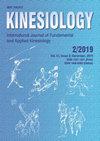Establishing frequency speed of kick test classificatory tables in male and female taekwondo athletes
IF 0.9
4区 医学
Q4 REHABILITATION
引用次数: 6
Abstract
Recently, the Frequency Speed of Kick Test (FSKT10s) and its intermittent version (5 x 10s/10s intervals, FSKTmult) have been used to assess physical fitness of taekwondo athletes, but no classificatory normative table was found for these tests. Thus, the aim of the study was to present two normative classificatory tables for both the FSKT10s and FSKTmult for male and female taekwondo athletes. One hundred fifteen male taekwondo athletes (median [interquartile range] age: 20 [17;27] years; body height: 175 [170;182] cm; body mass: 67 [60;78] kg; experience time: 6 [3;10] years) and seventy female taekwondo athletes (median [interquartile range] age: 19 [(17;24] years; body height: 162 [157;169] cm; body mass: 57 [50;64] kg; experience time: 5 [3;9] years) volunteered to participate in the study. Their skills ranged between 4th gub and 2nd dan. All the participants were evaluated during their competitive period and were familiarized with this test. The classificatory tables are presented in five scales, as follows: excellent (≥95th percentile); good (>75th percentile up to 94th percentile); regular (>25th percentile up to 74th percentile); poor (>6th percentile up to 24th percentile); and very poor (≤5th percentile). The classificatory tables for FSKT10s and FSKTmult can help coaches and strength and conditioning professionals to classify performance and monitor the physical fitness of taekwondo athletes in different stages of training and during the competitive season.建立男女跆拳道运动员踢腿测试频率速度分类表
近年来,跆拳道运动员的体能评价采用了踢腿频率测试(FSKT10s)及其间歇测试(5 × 10s/10s间隔,FSKTmult),但尚未找到分类规范的测试表。因此,本研究的目的是为男女跆拳道运动员的FSKT10s和fsktmult提出两个规范的分类表。115名男性跆拳道运动员(年龄中位数[四分位数间距]:20岁[17;27]岁;身高:175 [170;182]cm;体重:67 [60;78]kg,体龄:6[3;10]年)和70名女跆拳道运动员(年龄中位数[四分位数间距]:19[17;24]岁;身高:162 [157;169]cm;体重:57 [50;64]kg;经验时间:5[3;9]年)自愿参加本研究。他们的技能在四段和二段之间。所有的参与者都在比赛期间进行了评估,并熟悉了这个测试。分类表分为5个等级:优(≥95百分位);良好(从75个百分位到94个百分位);常规(bbbb25 - 74百分位);较差(从1960年的第6百分位到第24百分位);非常差(≤5百分位)。fskt10和FSKTmult的分类表可以帮助教练和力量调节专业人员对跆拳道运动员在不同训练阶段和比赛期间的表现进行分类和监测。
本文章由计算机程序翻译,如有差异,请以英文原文为准。
求助全文
约1分钟内获得全文
求助全文
来源期刊

Kinesiology
REHABILITATION-SPORT SCIENCES
CiteScore
1.90
自引率
8.30%
发文量
16
审稿时长
>12 weeks
期刊介绍:
Kinesiology – International Journal of Fundamental and Applied Kinesiology (print ISSN 1331- 1441, online ISSN 1848-638X) publishes twice a year scientific papers and other written material from kinesiology (a scientific discipline which investigates art and science of human movement; in the meaning and scope close to the idiom “sport sciences”) and other adjacent human sciences focused on sport and exercise, primarily from anthropology (biological and cultural alike), medicine, sociology, psychology, natural sciences and mathematics applied to sport in its broadest sense, history, and others. Contributions of high scientific interest, including also results of theoretical analyses and their practical application in physical education, sport, physical recreation and kinesitherapy, are accepted for publication. The following sections define the scope of the journal: Sport and sports activities, Physical education, Recreation/leisure, Kinesiological anthropology, Training methods, Biology of sport and exercise, Sports medicine and physiology of sport, Biomechanics, History of sport and Book reviews with news.
 求助内容:
求助内容: 应助结果提醒方式:
应助结果提醒方式:


